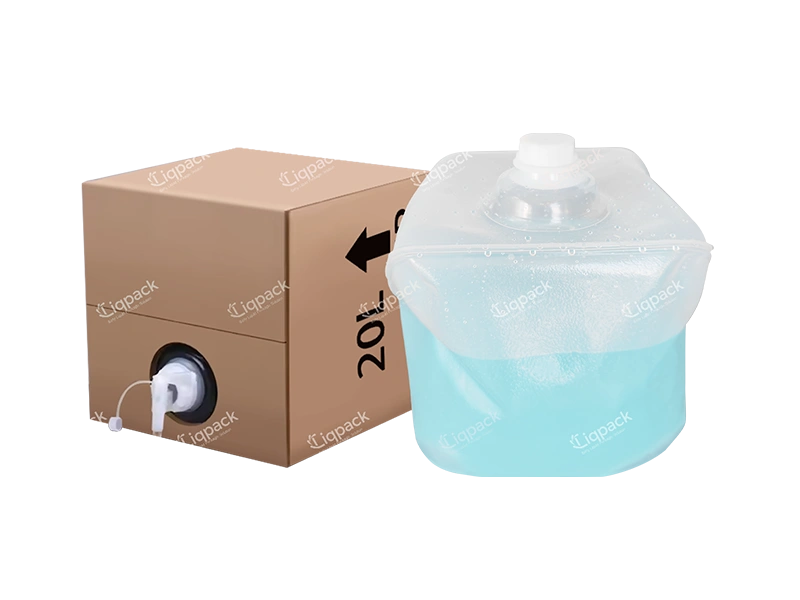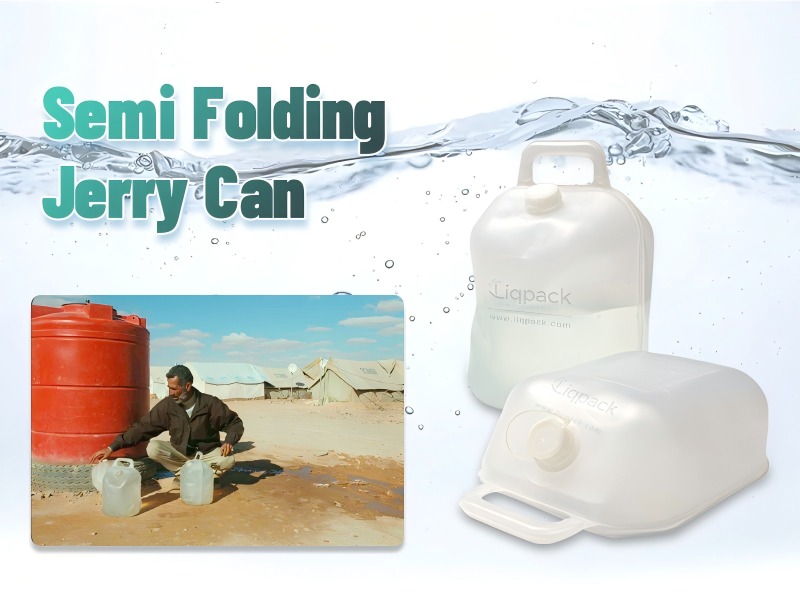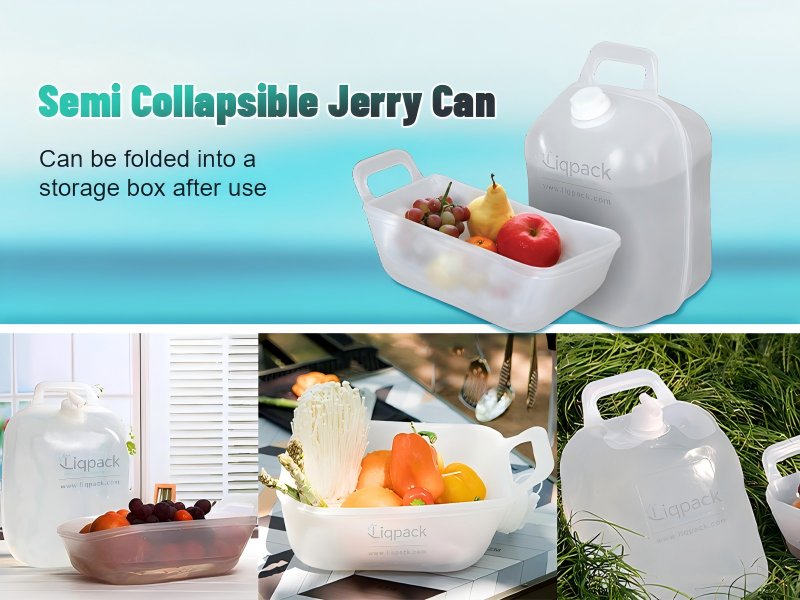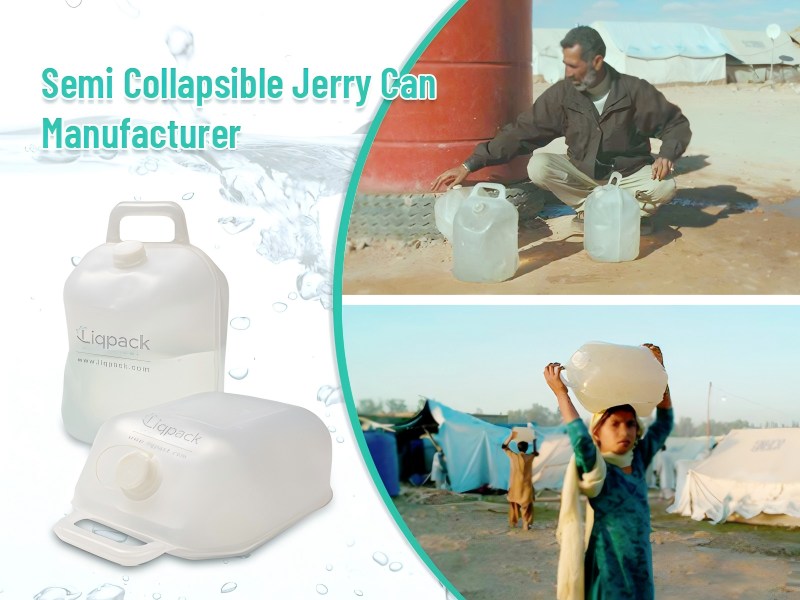
In the world of flexible packaging for liquids, four commonly used solutions have emerged as practical choices for diverse needs: Cubitainers, Collapsible Water Containers, Foldable Jerry Cans, and Collapsible Water Bags. Whether for outdoor camping, emergency preparedness, industrial liquid storage, or humanitarian relief, selecting the right type of container can significantly impact usability, cost-efficiency, transport logistics, and safety.
This article compares these four packaging solutions across several key factors—design structure, material composition, durability, use case scenarios, environmental footprint, reusability, and cost-effectiveness—to help you decide which option fits your specific needs.
Understanding the Basics

Cubitainer
A cubitainer is a semi-rigid, collapsible liquid container that consists of a flexible inner bag (usually LDPE) and an outer cardboard box or plastic shell. It combines the space-saving benefits of collapsible packaging with the protective qualities of stiff containers. Sizes commonly range from 1L to 25L, with 5L, 10L, and 20L being the most widely used.
Collapsible Water Container
This is a soft-sided container made of food-grade plastic (LDPE or HDPE) designed for easy transport and storage of water. Designed with a user-friendly screw cap or tap and a convenient built-in handle. These containers collapse as the water is consumed, making them ideal for camping, home storage, and emergency use.
Inspired by traditional rigid Jerry cans used in military and field operations, the foldable version is made of flexible but reinforced PE or TPU material. It includes multiple carry handles, a wide-mouth spout, and strong seams for durability. Capacity typically ranges from 10L to 25L, and it can be folded flat when empty.
Collapsible Water Bag
This is a lightweight, pouch-style container used mainly for personal hydration or small-volume storage. Made from TPU, EVA, or multilayer PE films, these bags are ultra-compact and portable, often used in outdoor recreation, hiking, or humanitarian aid.
Material & Structural Comparison
| Feature | Cubitainer | Collapsible Water Container | Foldable Jerry Can | Collapsible Water Bag |
| Material | LDPE inner + outer shell | Food-grade LDPE/HDPE | Reinforced PE or TPU | TPU, EVA, PE-laminates |
| Collapsible | Yes | Yes | Yes | Yes |
| Shape | Rectangular/Box | Boxy/Drum | Boxy/Can-shaped | Pouch/Sack |
| Self-standing | Yes (with outer box) | Often | Yes | No (depends on volume) |
- Cubitainers offer semi-rigid support with excellent chemical resistance.
- Foldable Jerry cans and collapsible containers have stronger grip handles and standing stability.
- Water bags are the most compact but often lack a self-supporting structure.
Portability and Storage
| Feature | Cubitainer | Collapsible Water Container | Foldable Jerry Can | Collapsible Water Bag |
| Weight (empty, 10L) | ~0.4 kg | ~0.3–0.5 kg | ~0.6–0.8 kg | ~0.2–0.3 kg |
| Foldable Size | Medium | Compact | Flat and sturdy | Ultra-compact |
| Handle Design | Single grip | Built-in handle | Dual handle | No or strap only |
| Transport Suitability | Moderate | High | Very High | Very High |
- Water bags are best for backpacking or ultralight travel.
- Foldable jerry cans are ideal for rugged outdoor environments.
- Cubitainers take up more space due to the outer shell, but are more stable in storage.
Durability and Strength
| Feature | Cubitainer | Collapsible Container | Foldable Jerry Can | Collapsible Water Bag |
| Durability | Medium (inner bag prone to wear) | Medium | High | Low to Medium |
| Puncture Resistance | Moderate | Moderate | High | Low |
| UV Resistance | Limited | Varies | High (UV-protected) | Limited |
| Drop Resistance | Fair | Fair | Good | Poor |
- Foldable Jerry cans are reinforced for heavy-duty use.
- Cubitainers are safe for industrial use but may tear if mishandled.
- Water bags need protection from sharp objects and excessive pressure.
Reusability and Cleaning
| Feature | Cubitainer | Collapsible Container | Foldable Jerry Can | Collapsible Water Bag |
| Reusability | Moderate | Moderate | High | Low to Moderate |
| Easy to Clean | Moderate | Moderate | Yes (wide mouth) | Difficult |
| Mold/Bacteria Resistance | Depends on use | Depends on material | High with care | Low |
- Foldable Jerry cans are easier to clean due to their wide openings.
- Cubitainers can be reused if used with care and not contaminated.
- Water bags are usually for single-use or short-term hydration purposes.
Use Case Scenarios
| Application Area | Best Option(s) |
| Emergency water storage | Collapsible Container, Cubitainer |
| Camping / Hiking | Water Bag, Foldable Jerry Can |
| Industrial liquid packaging | Cubitainer |
| Military / Field operations | Foldable Jerry Can |
| Outdoor events/transport | Collapsible Container, Jerry Can |
| Backpack travel hydration | Collapsible Water Bag |
| Medical or chemical usage | Cubitainer |
Each option suits a specific scenario:
- Cubitainers are the top choice for controlled, bulk liquid dispensing (e.g., hemodialysis reagents, chemicals).
- Foldable jerry cans excel in field use, survival, and military-grade reliability.
- Collapsible containers balance affordability and household usability.
- Water bags are excellent for one-person hydration or ultralight use.
Capacity and Customization Options
| Container Type | Capacity Range (L) | Customization Options |
| Cubitainer | 1 – 25 L | Outer print, tap/nozzle, cap type |
| Collapsible Container | 3 – 20 L | Tap style, shape, color |
| Foldable Jerry Can | 5 – 25 L | Handle style, color, and labeling |
| Collapsible Water Bag | 1 – 10 L | Strap, mouthpiece, logo |
- Cubitainers are best for OEM industrial customization.
- Jerry cans allow the most rugged custom configurations.
Cost Efficiency
| Type | Unit Cost (10L) | Shipping Efficiency | Cost Per Use |
| Cubitainer | $2.50 – $5.00 | High | Moderate |
| Collapsible Container | $1.50 – $4.00 | High | Low to Moderate |
| Foldable Jerry Can | $6.00 – $12.00 | Medium | Low (long life) |
| Collapsible Water Bag | $1.00 – $3.00 | Very High | High (often single-use) |
- Collapsible water bags are cheap up front, but not durable.
- Foldable jerry cans have a higher initial cost but provide long-term savings through reuse.
- Cubitainers offer a good price-to-volume ratio for one-time or semi-reuse scenarios.
Environmental Considerations
| Feature | Cubitainer | Collapsible Container | Foldable Jerry Can | Collapsible Water Bag |
| Recyclability | Partial (outer box) | Yes (if HDPE) | Yes (HDPE/TPU) | Limited (depends on film) |
| Reusability | Moderate | Moderate | High | Low |
| Waste Impact | Medium | Low to Moderate | Low | High |
For sustainability:
- Foldable jerry cans and collapsible containers are the most eco-friendly, properly disposed of, and reused.
- Water bags contribute more to plastic waste if used only once.
Summary: Which One Is Right for You?
| Scenario | Recommended Container |
| You need compact storage and light use | Collapsible Water Bag |
| You need emergency home water storage | Collapsible Water Container |
| You need durable field use | Foldable Jerry Can |
| You need a hybrid of flexibility + volume | Cubitainer |
| You want long-term, rugged reuse | Foldable Jerry Can |
| You are transporting chemicals | Cubitainer |
| You are backpacking or hiking | Collapsible Water Bag |
Conclusion
Each of these packaging solutions—Cubitainer, Collapsible Water Container, Foldable Jerry Can, and Collapsible Water Bag—offers a distinct advantage in specific scenarios. Your application requirements, durability requirements, storage limitations, and financial restraints will all influence the optimal option.
- Cubitainers strike a balance between flexible storage and industrial usability.
- Collapsible containers offer affordable, compact solutions for short-term or residential needs.
- Foldable Jerry cans provide unmatched durability and multi-use reliability.
- Water bags are ultra-light and perfect for single-person use in hiking or emergencies.
Whether you’re preparing for a camping trip, building an emergency kit, or packaging chemicals for global shipping, choosing the right container helps you manage liquids efficiently, safely, and sustainably.
- Liqpack



